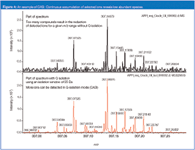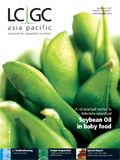Rapid Compound Identification from Crude Oil Enabled by Fourier Transform Ion Cyclotron Resonance Mass Spectrometry
LCGC Asia Pacific
The analysis of crude oil by means of different atmospheric pressure ionization (API) techniques is described. Crude oil is analysed without any separation prior to API-Fourier transform mass spectrometry. The use of a quadrupole/hexapole device to selectively enhance a certain mass range is demonstrated. Automated generation of molecular formulas from accurate mass measurements enables rapid compound identification.
Jens Fuchser and Matthias Witt, Bruker Daltonik GmbH, Bremen, Germany.
Introduction
Crude oil is known as a very complex mixture of organic compounds with various elemental compositions and chemical structures. An important analytical task in the oil industry is to quickly identify compounds from crude oils that could potentially harm the production plant. Therefore, detailed and quantitative information about the compound types in crude oil is of high interest for a molecular-based management of the refining process.
Isolation of single compounds is only partially possible with liquid chromatography, capillary electrophoresis or other separation methods because of the complexity of this mixture. Only ultrahigh-resolution Fourier transform ion cyclotron (FTICR) mass spectrometry with a resolving power of more than 300000 can provide this separation in mass, thus giving an insight into the distribution of compounds within a given complex mixture. The use of FTICR mass spectrometry for the assignment of compound classes as well as the elemental composition of single compounds of crude oil has been shown previously.1,2
The speciation of heteroatomic compounds, especially nitrogen and sulphur, is important because of their ultimate fate as NOx and SOx emissions upon combustion as well as their corrosive character for the production plant. The presence of such compounds in crude oil is also of interest for the understanding of asphaltenes and their deposition in pipelines for example.3 As a result of the tremendous complexity of the spectra (Figure 1) an automated processing of the data is mandatory.

Figure 1
Experimental
Analyses were accomplished using an apex Qe 9.4 T (Bruker Daltonics, Billerica, Massacusetts, USA), which was equipped with an external quadrupole/hexapole device, and a DualSource (Bruker Daltonics), which was operated in positive or negative ion mode. Infusion experiments in Electrospray Ionization (ESI), Atmospheric Pressure Chemical Ionization (APCI) and Atmospheric Pressure Photo Ionization (APPI) (Syagen, Tustin, California, USA) were performed by changing to the appropriate spray chamber (change-over in less than a minute).
To prepare the spray solution 20 μL crude oil was dissolved in 1 mL toluene and further diluted 1:9 in 85% MeOH/15% toluene. This solution was sprayed at 120 μL/h for ESI and at 12 mL/h for APPI and APCI, respectively.
Data evaluation: Data evaluation was performed with Generate Molecular Formula (GMF) in TargetAnalysis (Bruker Daltonik, Bremen, Germany). The GMF module allows for setting various constraints for the molecular formula search. Here, the following constraints were used: max. molecular formula: CaHbN3O30S3, H/C ratio: 0.2 ≤ H/C ≤ 2.5, nitrogen rule: yes (APPI pos: no), mass tolerance: 0.5 ppm. The resulting molecular formulas were displayed using Kendrick plots. The relative abundances of compound classes were calculated from the respective MS intensities.
Results
For all measurements molecular formula were generated and displayed in Kendrick plots (Figure 2). As a result of the very accurate mass detection using FTICR mass spectrometry the detailed analysis of Kendrick plots reveals series of homological compounds.

Figure 2
The comparison of these distributions shows that polar compounds have been detected very efficiently using ESI, whereas non-polar compounds can be detected with APCI as well as APPI more effectively. The abundance of the detected compound classes depending on the ionization technique and ionization mode is shown in Figure 3.

Figure 3
APPI (besides APCI) proved very useful technique for the analysis of non-polar compounds like hydrocarbons. Also, in positive ion mode APPI was the most efficient method to ionize compounds such as CaHbN2S2Ox, CaHbN2SOx and CaHbN2Ox. However, using APPI in positive ion mode one has to take into account that [MH]+ as well as [M]+ ions are detected.4
Setting a certain isolation mass range (e.g. Δ m/z 50) in the external quadrupole allows for selectively enhancing low abundant species which are otherwise suppressed. The effect of this continuous accumulation of selected ions (CASI) is demonstrated in Figure 4.

Figure 4
In summary more than 14000 compounds have been identified (Table 1) using all ionization techniques, which clearly shows the need for different ionization techniques to gain a better understanding of the compositions of complex mixtures.

Table 1: Molecular formulae identified by different ionization methods.
Conclusion
We demonstrate the use of ultrahigh accurate mass measurements in combination with automated elucidation of molecular formula. Only the combination of different ionization techniques and ultra high resolution mass spectrometry gives utmost insight into complex mixtures such as crude oil, which are not readily resolved by chromatographic strategies. In addition, selectively enhancing certain mass areas by means of CASI reveals low abundant species.
Therefore, ESI-, APCI-and APPI-FTICR mass spectrometry are very important and complementary tools for the rapid analysis of crude oil.
References
1. A.G. Marshall, Energy and Fuels, 15, 492 (2001).
2. R.P. Rodgers et al., Anal. Chem., 77, 21A (2005).
3. A.G. Marshall et al., Acc. Chem. Res., 37, 53 (2004).
4. J.P. Purcell et al., Anal. Chem., 78, 5906 (2006).

Bruker Daltonics Inc.
Region Asia Pacific
E-mail: Bruker.AsiaPacific@bdal.com
Website: www.bdal.com
Bruker Daltonik GmbH
Fahrenheitstrasse 4, 28359 Bremen, Germany
tel. +49 421 2205 0 fax +49 421 2205 104

The Benefits of Custom Bonded Silica
April 1st 2025Not all chromatography resins are created equal. Off-the-shelf chromatography resins might not always meet the rigorous purification requirements of biopharmaceutical manufacturing. Custom bonded silica from Grace can address a wide range of separation challenges, leading to real performance improvements. Discover more about the latest innovations in chromatography silica from Grace, including VYDAC® and DAVISIL®.
5 Things to Consider When Selecting a Chromatography Silica
April 1st 2025Particularly in the pharmaceutical industry, drug purity isn’t just a goal – it’s essential for achieving safety, stability and efficacy. However, purification is easier said than done, especially with challenging molecules like DNA and RNA “oligonucleotides,” due in large part to their diversity and the range of impurities that can be generated during production. Enter DAVISIL® chromatographic silica, with a wide range of pore diameters and particle sizes to meet your specific application, performance and sustainability requirements. Before you choose the chromatography resin for your next purification application, take a look at these 5 considerations.
Automating Protein Purification: Efficiency, Yield, and Reproducibility
March 27th 2025Recent advancements in automated protein purification stress the importance of efficiency, scalability, and yield consistency. This eBook compares different purification platforms, highlighting their impact on downstream applications and demonstrating how automation enhances throughput and process control.
MilliporeSigma: Ultrapure Water for Sensitive LC-MS Analysis of Pesticides
March 25th 2025The aim of the study was to illustrate the efficiency of Milli-Q® water purification systems in eliminating pesticides from tap water, thereby producing and delivering reliable and consistent-quality ultrapure water suitable for pesticides analysis







